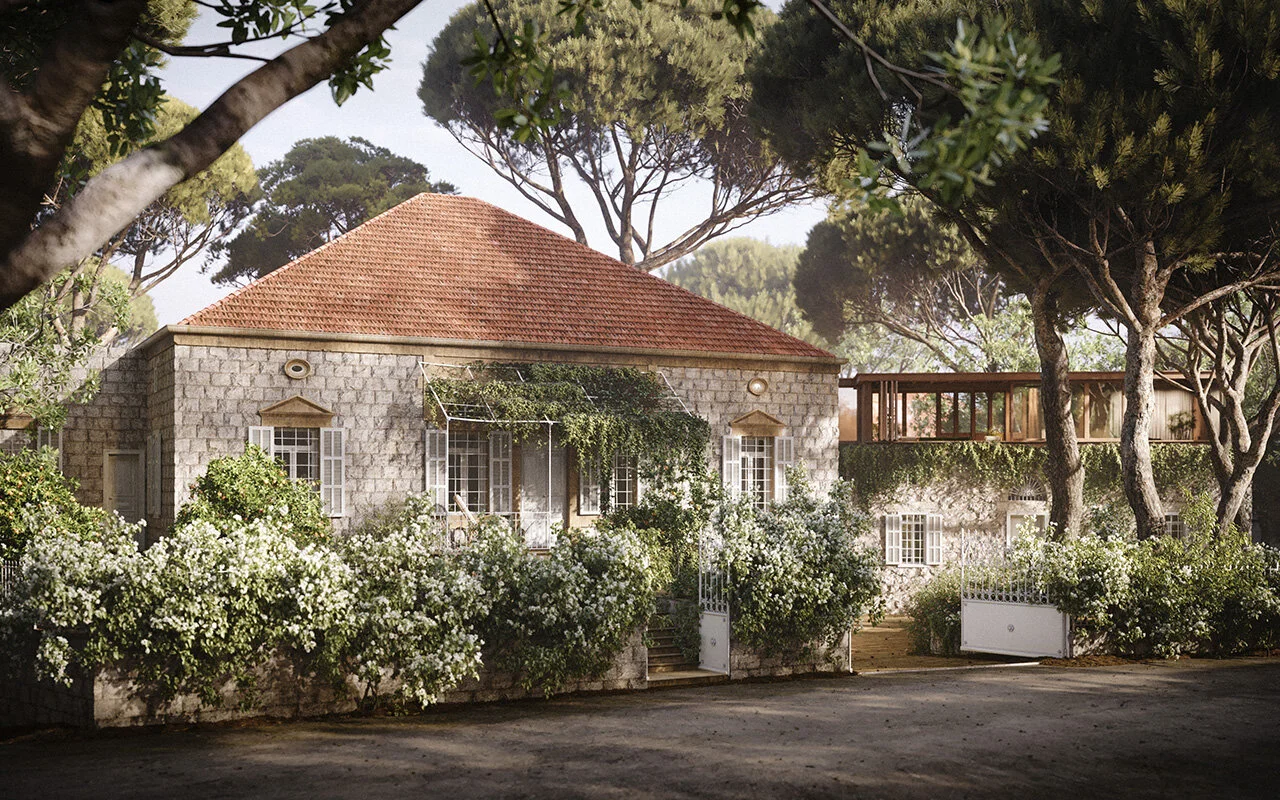VILLA NADIA || A Revitalized Heritage Home Preserves its Rich History

From a distance, the picturesque Villa Nadia seems to have emerged from a painting.
A tranquil surrounding filled with native, Mediterranean plants complements the revitalized heritage house with a rich history. What used to be an abandoned house with broken doors, barricaded windows, ruptured ceilings, and wilted gardens have now re-emerged as an elegant family home that pays tribute to the site’s Lebanese heritage and its resilience over the years.
Revitalized by Beirut-based architecture studio, Carl Gerges Architects, the design team paid close to preserving the natural aging effects and historical layers of the original architecture. As a result of the sympathetic restoration, traces of past stories can often be discovered throughout the house - from the majestic archways to the charming stone-clad facade.
The house’s main facade is hidden behind bougainvillea plants and pine trees, providing privacy for the residence. The building’s characteristic red-tiled roof and triple-arched windows are the first to make an appearance, extending above the barricade of plants. Upon arrival, guests are immediately welcomed with the delicate scents of orange blossom, jasmine and citrus trees on the property - an ode to plants commonly found in traditional Lebanese gardens.
The spacious main hall is filled with natural, green-tinted light filtered by the lush greenery from the exterior gardens, giving a sense of serenity and calmness. Timber frameworks on the five-metre high ceiling along with walls clad in cane matting add complexity and elegance to the main hall. Walking past the living space and though the timeless arches, one will be welcomed into the bright and airy dining room where the warm sunlight illuminates the space and its adjacent indoor garden.
A gathering space within Villa Nadia
To pay tribute to the original wallpaper in the original home, the walls are upholstered with a taupe green fabric and ornamented with gold leaf-plated Orthodox Russian icons. Facing the dining area, a large door opens into an outdoor botanical garden that guides you into the enchanting glasshouse, or jardin d’hiver, through an eclectic selection of native and tropical plant species.
Complemented with a harlequin patterned floor, glass roof, and an intricate white gate that looks out to the central courtyard, the private and secluded glasshouse is the perfect place for an afternoon alone with a great book or a picturesque space to entertain during the day.
The bright and airy dining room
The exterior of the Glass House
Looking into the Glass House from the dining area
The library was previously the house’s staff quarter and takes on a slightly less embellished nature compared to the rest of the house. Built with natural pine tree barks and branches, the room gives off an organic and grounded feel to create a calming environment free of distraction. The ceiling’s unpolished wood beams, terracotta floor, and Morrocan Tuareg mat complement the setting with their natural and earthy attributes. The only element that takes on a contemporary quality is the white steel spiral staircase, which leads to the top floor guesthouse.
The library
The guesthouse, located on the upper floor of the building, was inspired by modern tree house design - a space highlighted by openness and warmth, enveloped in the beauty of natural wood. Looking out to the tall pine trees, guests will feel as if they’re nestled within the height of the trees where the surrounding lush draping greens and warm sunlight offers a tranquil day’s retreat.
Guest house inspired by modern treehouse
The intimate spa
In the vaulted basement, the one-meter thick walls completely isolate the space from sound and light, creating an ideal setting for an intimate earthy spa. Completed with reflective plastering on the walls and flooring, this elemental space emits feelings of intimacy within an age-old shimmering cave.
Two solid Carrara marble slabs are stationed as massage benches behind the majestic pool. A custom-made, American walnut wood sauna, a steam room, and showers seamlessly blend into the space at the end of the cave behind glass panels. To add to the atmosphere, flickering candles illuminate the space and bring life with its subtle movements.
Much like the other works of Carl Gerges Architects, Villa Nadia is an example of how one can create luxury, functionality, and flair to a heritage home without compromising its integrity. The new and revived Villa Nadia is not only a home for a new family but also a place where one can discover bits and pieces of the site’s rich history if you look close enough.
PROJECT DETAILS
PROJECT: VILLA NADIA
DESIGN STUDIO: CARL GERGES ARCHITECT
TYPE: PRIVATE RESIDENCE
LOCATION: BEIT MERY, LEBANON
AREA: 1300 SQM
YEAR: 2020
PHOTOGRAPHY: CARL GERGES ARCHITECT

















